owned this note
owned this note
Published
Linked with GitHub
# SYMBIOTIC BIOPRODUCTION
TREE whispering - How to establish a dialogue with trees?
> documentation in progress... please excuse the mess

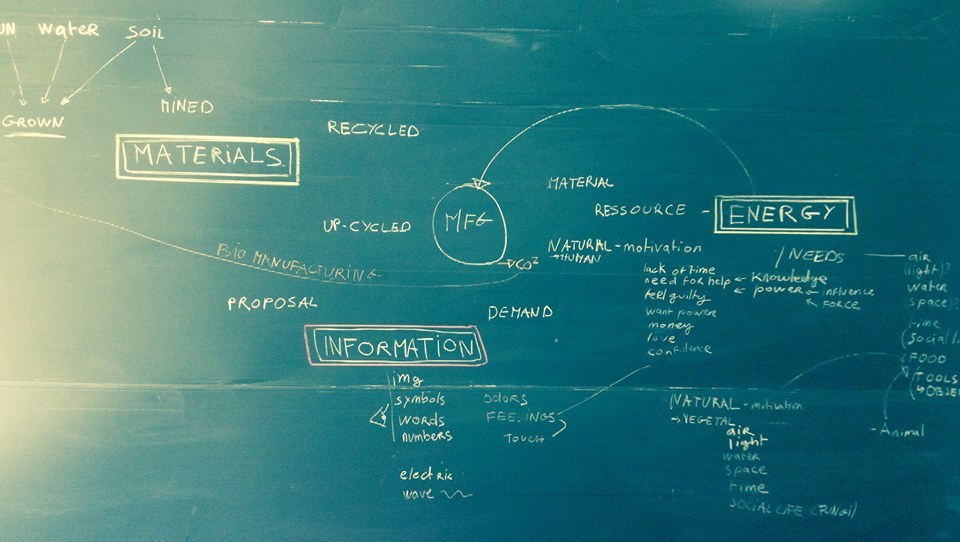
# **Video abstract**
<iframe src="https://player.vimeo.com/video/221103020" width="640" height="360" frameborder="0" allowfullscreen></iframe>
# **Context and Aim**
The [TreeCoach](https://hackpad.com/HITXVMOYZaI) project is a open source Art and Science project led by [Les Usines Louise](https://www.lesusineslouise.com/) (LUL) and powered by [la Paillasse Saône, an ecohacklab in Lyon](https://lapaillassaone.wordpress.com/).
The aim is to develop a new method of furniture/structure production: a "symbiotic biomanufacturing proces". Originally we wanted to learn how to grow structural elements from trees, using communication techniques derived from observation of their natural way of growing (vegetal ethology) and rejecting abusive training methods. This method of production could have been called tree whispering, in relation to the training method used with horses.
The longer term goal was to produce living furniture/housing and other structural elements such as [bicycle frames](/Grow-faire-pousser-des-vlos-Jy21YU3o2pE) directly from growing trees, making it a CO2 consuming process and participating to a new economy of low to positive impact mfg processes. (The trees would be pruned to preserve them and maintain the integrity of the forest across generations.)
> At this stage, the primary focus is **reciprocity** **and observation**- to steer clear of the assumption that nature is there for humanity's personal use.
## FOREST as a DAO
Further research and exploration of the blockchain technology, brings forth the idea of a possible reciprocal relationship based on the idea of a forest as a DAO. And the right for nature to have rights.
> Forest as a natural DAO (decentralized autonomous organization would give each tree a legal voice trough a unique id on the blockchain.
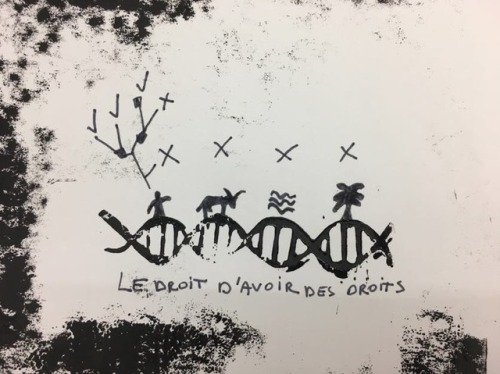
Forest as a DAO is an ongoing experimental project linking blockchain technologies, art and environment. Through a common online platform it allows for economic interactions between plants, digital art and users using an Ethereum Smart Contract.
<iframe width="560" height="315" src="https://www.youtube.com/embed/RqzacydZFhE" frameborder="0" allow="autoplay; encrypted-media" allowfullscreen></iframe>
> 𝕊𝕔𝕚𝕖𝕟𝕔𝕖-𝕗𝕚𝕔𝕥𝕚𝕠𝕟 𝕠𝕣 𝕤𝕠𝕔𝕚𝕒𝕝 𝕣𝕖𝕒𝕝𝕚𝕥𝕪, 𝕥𝕙𝕖 BLOCKCHAIN. FACT. FICTION. FUTURE. 𝕖𝕧𝕖𝕟𝕥 𝕓𝕣𝕠𝕦𝕘𝕙𝕥 𝕥𝕠𝕘𝕖𝕥𝕙𝕖𝕣 𝕒𝕣𝕥𝕚𝕤𝕥𝕤, 𝕒𝕔𝕥𝕚𝕧𝕚𝕤𝕥𝕤, 𝕙𝕒𝕔𝕜𝕖𝕣𝕤, 𝕕𝕖𝕤𝕚𝕘𝕟𝕖𝕣𝕤, 𝕤𝕔𝕚𝕖𝕟𝕥𝕚𝕤𝕥𝕤, 𝕤𝕠𝕔𝕚𝕠𝕝𝕠𝕘𝕚𝕤𝕥𝕤 𝕒𝕟𝕕 𝕡𝕠𝕝𝕚𝕥𝕚𝕔𝕒𝕝 𝕤𝕔𝕚𝕖𝕟𝕥𝕚𝕤𝕥𝕤 𝕥𝕠 𝕒𝕟𝕒𝕝𝕪𝕤𝕖, 𝕢𝕦𝕖𝕤𝕥𝕚𝕠𝕟, 𝕒𝕟𝕕 𝕕𝕚𝕤𝕔𝕦𝕤𝕤 𝕥𝕙𝕖 𝕕𝕚𝕤𝕣𝕦𝕡𝕥𝕚𝕧𝕖, 𝕔𝕦𝕝𝕥𝕦𝕣𝕒𝕝 𝕒𝕟𝕕 𝕔𝕣𝕖𝕒𝕥𝕚𝕧𝕖 𝕡𝕠𝕥𝕖𝕟𝕥𝕚𝕒𝕝 𝕠𝕗 𝕥𝕙𝕚𝕤 𝕥𝕖𝕔𝕙𝕟𝕠𝕝𝕠𝕘𝕪.
𝕚𝕄𝔸𝕃, 𝔹𝕣𝕦𝕤𝕤𝕖𝕝𝕤, 𝟜 ℕ𝕠𝕧𝕖𝕞𝕓𝕖𝕣 𝟚𝟘𝟙𝟞
[http://imal.org/en/activity/blockchain-fact-fiction-future]
Looking back at the Plantoid project initiated last year at the Ars Electronica festival by Primavera de Filippi: A short story about the artist and nature lover perspective on the blockchain or why Forest as a natural DAO (decentralized autonomous organization) could be a step towards symbiotic bioproduction.
>
Initiated in February 2016 in Lausanne, the Plantoid/Forest as a DAO project has since been part of Learn Do Share Paris, Blockchain Fact Fiction at IMAL Brussels and the Biennale of Design in Saint Etienne, the first Lyon Architectural Biennal and a few more lectures around France.


https://vimeo.com/293965261
<iframe src="https://player.vimeo.com/video/293965261" width="640" height="360" frameborder="0" webkitallowfullscreen mozallowfullscreen allowfullscreen></iframe>
<p><a href="https://vimeo.com/293965261">bioproduction symbiotique LUL</a> from <a href="https://vimeo.com/user41163971">MYNOSA</a> on <a href="https://vimeo.com">Vimeo</a>.</p>
## About the author
Isabelle Humbert-Radtke (FR)
Sculptor & engineer, Les Usines Louise
Forest as a DAO (The Plandoid project: context, et prospectives)
Isabelle Radtke is sculptor and bio-hacker at La Paillasse Saône. She created the LUL project to give shape to an intuition she called “tools to think with your hands” that shifts the creative process towards sustainable and frugal solutions. These tools will be invented and created by means of sketches, poetic and technical periods. As an open project, can get involved in its research. Doing so, Radtke hopes to instigate a co-creative process to develop an art form that would belong to those using and making it.
This project is open to collaboration, in many forms, LUL is currently working with 3D artist A.Dumenieu to create [poetic 3D models to virtually "enter" the trees perspective](https://sketchfab.com/models/eade0cd5f3e64f0b9121e3249ff32c7a/embed). Other collaboration include the collection of information in this pad and [testing of the real size prototypes.](https://vimeo.com/129195754)
# **INSPIRATION**
<iframe width="560" height="315" src="https://www.youtube.com/embed/eApivlACwv8" frameborder="0" allow="autoplay; encrypted-media" allowfullscreen></iframe>
[*https://www.youtube.com/watch?v=eApivlACwv8*](https://www.youtube.com/watch?v=eApivlACwv8)
*Notes* *from* ***S.Mancuso*** *video**: Plants represents 99,7% of the biomass on our planet. Objectively, humans and animals are only traces. so far, our scientific and societal development has been inspired by the way animals are made to a great extend, building command centered organs. Plants can inspire more democratic and modular solutions. We tend to look at life from an human centered point of view but we need some kind of* *C**opernical revolution... just li**k**e we removed earth as the center of the universe, we need to remove the human as the center of life.*
*Notes from Giles Deleuze and Felix Guattari "Rhizome VS. Tree* :*To plot a center-point, is the first step towards misunderstanding something that functions rhizomatically.....****The rhizome is acentered, non-hierarchical, nonsignifying system without a General and without an organizing memory or central automaton, defined solely by a circulation of states.****”*
*"les récentes découvertes [*sur les capacités de perception et de réaction des plantes] *ont fait évoluer les esprits. Elles changent radicalement notre vision des plantes, c’est une petite révolution. Ça va conditionner notre manière de les cultiver mais ça va encore au delà, les relations qu’on a avec les plantes vont être changées. On ne peut pas se contenter de leur balancer des produits. Il faut utiliser notre intelligence pour mettre à profit leurs capacités.* ***C’est un dialogue que nous devons inventer.****" Bruno Moulia - directeur de recherche à l’Inra (Institut national de recherche agronomique) dans l’Unité mixte de recherche « Physique et physiologie intégratives de l’arbre forestier ou fruitier »* [*http://www.terraeco.net/plantes-parlent-entre-elles,52244.html*](http://www.terraeco.net/plantes-parlent-entre-elles,52244.html)
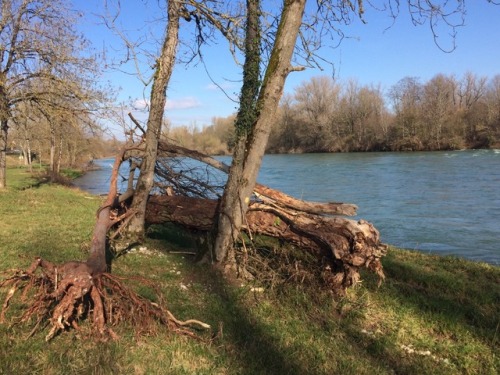
[Should Rivers Have Rights? A Growing Movement Says It’s About Time](https://e360.yale.edu/features/should-rivers-have-rights-a-growing-movement-says-its-about-time)
branching from [TreeCoach](/HITXVMOYZaI)
linked pad: MasterClass Biomimicry I Francis Hallé - Eloge de la Plante (fr) I [Treecoach structural option](/gFhsqNRO1Qb#Treecoach-structural-option)
[collective pad to collect information about the "SENSES OF PLANTS"](http://piratepad.net/E7Ys9h9FFs) I
**Work in progress:** [**Smart Forest**](https://lpsprojects.hackpad.com/Smart-Forest-oDFaWs4KEyF)
# **Prototypes** **(**[more pictures here](http://lesusineslouise.tumblr.com/)**)**



Le bourgeon #spring #FŌZMACHINE #TAV



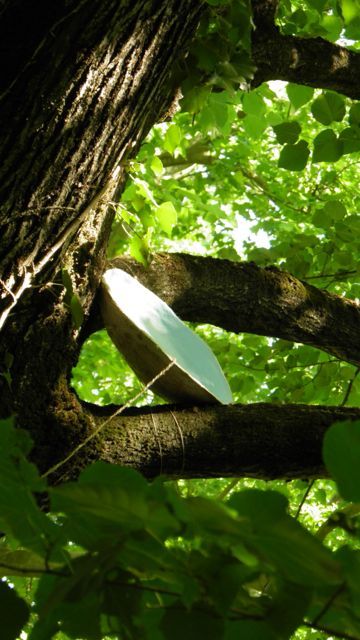
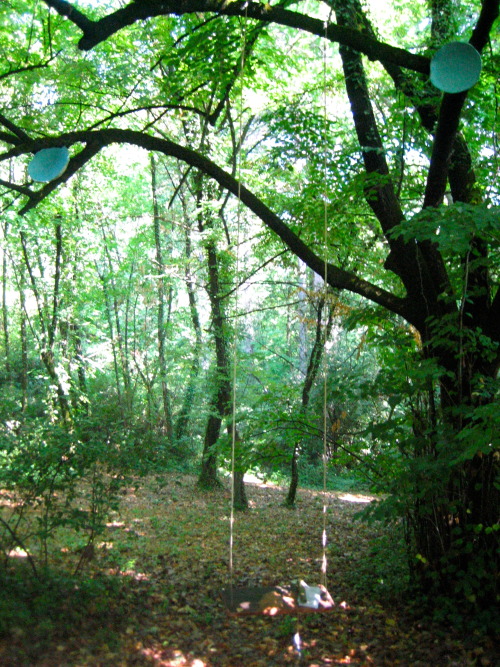
**June 2015**, installation in two linden tree, during the "circuit d'art épatant", Ardèche, France
see the video prototype here: [https://vimeo.com/129195754](https://vimeo.com/129195754)
There, a swing was set up, it was carved with a butt shape -as to look like someone had spent a lot of time there. Suggesting the time of the tree is so different from ours. lime-covered mental spaces were set up in a manner to suggest that some king of sound or wave length could be picked up and transmitted trough the system. Visitors were also asked to fill out a experiment log, to share what they thought the trees might need.
More info and images here: [http://lesusineslouise.tumblr.com/](http://lesusineslouise.tumblr.com/)



**September 2015**
Mental Spaces for the Trees :As a sculptor, I think with my hands, this is a process I am trying to document and share. Initially, I started making these sculptures I call "Mental Spaces" as a mean to create tools to think with your hand. The original ones where small bowl like shapes filled with an intense blue, meant to "hold" the ideas, allowing you to manipulate them.
These mental spaces are bigger, they are intended to be used - not by the trees- but as a support for human imagination, as a stepping stone to start looking at things from a tree point of view maybe?
As it turns out, plants have photosensitive pigments on their surface and they can feel blue sky and move towards light. So I am keeping the color blue for the prototypes.
More info and images here: [http://lesusineslouise.tumblr.com/](http://lesusineslouise.tumblr.com/)


photo @Caire Chauvel
**Tree coach** **Phase I** - 3 Mental Spaces - experience not defined
Plater, Lime, Pigments, 2015

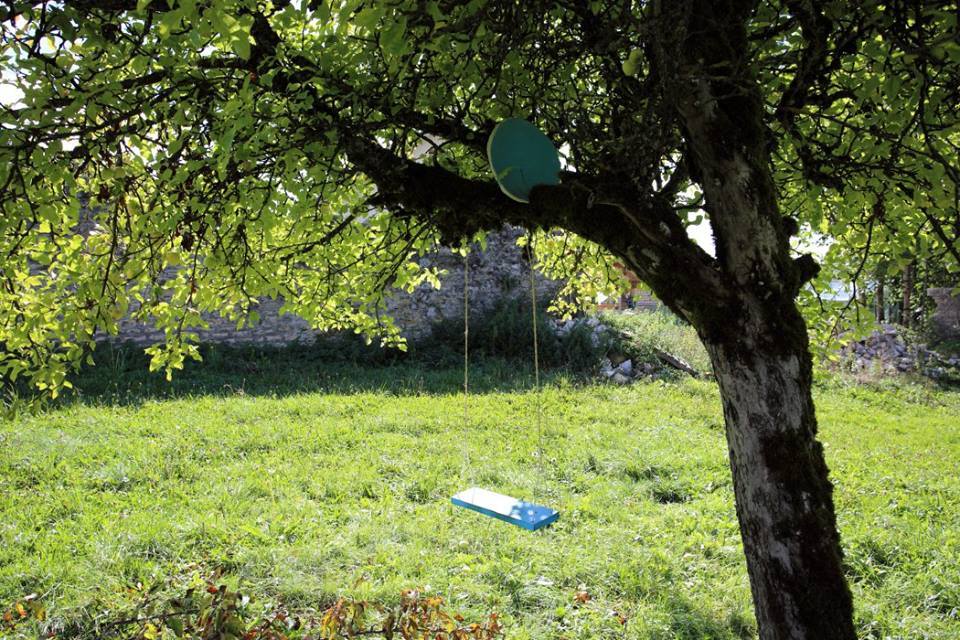
photo @Caire Chauvel
**Phase I** - 2 Mental Spaces - a swing - apple tree
Wood, Rope, Plater, Lime, Pigments, 2015

**Phase I** - 7 Mental Spaces -2 stone benches - 2 linden trees
Wood, Rope, Plater, Lime, Pigments, 2015
**Phase II**
... Starts a dialogue, using blue rectangular elements that could potentially induce phototropism and influence a branch to grow in a chosen direction.
... démarre une forme de dialogue, en proposant des éléments de couleur bleue, induisant un phototropisme et pouvant motiver l’arbre à faire pousser une branche dans une direction spécifique.


**Phase II** - straight tool - linden trees
Steel, blue paint, 2015
# **Documentary research**
[ ] à voir: [http://www.inra.fr/Chercheurs-etudiants/Biologie-vegetale/Tous-les-dossiers/Sentir-bouger-communiquer-les-plantes-aussi/Sensibilite-et-motricite-coordonnee/(key)/0#.V3rWySuvwqo.twitter](http://www.inra.fr/Chercheurs-etudiants/Biologie-vegetale/Tous-les-dossiers/Sentir-bouger-communiquer-les-plantes-aussi/Sensibilite-et-motricite-coordonnee/(key)/0#.V3rWySuvwqo.twitter)
**Smelling the tree/hormonal interaction**
A voir:
[ ] science de la communication, science de la complexité
[ ] **Protéodie** [**http://www.genodics.net/**](http://www.genodics.net/)
science créée par Joël Sternheimer, la génodique, et qui influencerait entre autres l'auxine, l'hormone de croissance des plantes
[ ] **tropisme**
[ ] **phéromones**
[Plant cells communicate with one another via messengers called hormones,chemical signals produced by one type of cell that travel to target cells and cause changes in their growth or development. Plant hormones control many familiar plant behaviors.](http://www.dummies.com/how-to/content/how-plants-send-signals-with-plant-hormones.html) voir TREEcoach hormones
Notes from: Plant neurobiology: from sensory biology, via plant communication, to social plant behavior Frantisˇek Balusˇka Æ Stefano Mancuso
"Auxin, besides hormone- and morphogen like properties, also possesses neurotransmitter-like properties".
About plant neurobiology : " We need to understand how those processes transform **physical information** (e.g., light, gravity, temperature, mechanical and osmotic forces, etc.) into **biological information**. Particularly, we need to know if it is possible to convert physical information directly into biological information without inducing any bioelectrical responses, or if physical sensory information needs to be first transformed into **bioelectrical information** before it can be translated into purely biological information."
" auxin fulfils the minimum criterion for being a neurotransmitter-like signaling molecule
in plants. We expect that plant synapses will be, similarly like synapses in animal and human brains, integrating sensory inputs to allow experience-based behavior and cognition. In fact, plant cognition is another just emerging topic of plant sciences."
"Plants perform neuronal-like computation not just for rapid and effective adaptation to an ever-changing physical environment but also for the sharing of information with other plants of the same species. In fact, plants emerge as social organisms."
" by using a vast diversity of volatiles, plants are able to attract or repel diverse insects and animals, and thereby are able to shape their biotic niche. The number of volatile compounds released and received by plants for communication is immense, requiring complex signal-release machinery, as well as an unprecedent ‘neuronal’ decoding apparatus for correct interpretation of received signals. These aspects of plant activity have not yet been studied
yet."
" Human perception of the outside world relies on a so called ‘neural code,’ which links sensory signals and neuronal responses. Similarly, in plants, numerous parameters of the physical environment, especially, light, temperature, and gravity, are continuously monitored. Polar auxin transport translates perceived and processed sensory information into adaptive
physiological, developmental, and motoric responses.
Structural and developmental plasticity of plants resembles experience-based plasticity of neurons and neuronal networks in brains. **New concepts are needed, and new questions must be asked, for advancing our rudimentary understanding of the communicative nature of sensory plants."**
**A "nose"** *,* someone that will be able to detect and differentiate smells emitted by trees.
*"At sunrise, the trees start pumping out a complex mix of volatile organic compounds (VOCs), such as pine-scented terpenes. By mid-morning, the westerly breeze adds a dose of the VOC isoprene from oak woodlands about 30 kilometres away...."* [Chemist Allen Goldstein has spent his career tracking elusive compounds emitted by trees](http://www.nature.com/news/2009/090527/full/459498a.html)
**Ceramics,** especially if heated to high temperature and cooled fast will have a complex surface (lots of crystallisation) and will "attract" most odour molecules. ... it could eventually be possible to create the right surface geometry to catch specific molecules... however, they will still need to be analysed and interpreted
**Humans have a “olfactory positioning system”** The process of smelling, or olfaction, is triggered by odor molecules traveling up the nasal passage, where they are identified by receptors that send signals to the olfactory bulb—which sits between the nasal cavity and the brain’s frontal lobe—and processes the information. A key to the connection between smell, memory and navigation is that olfactory bulbs have a strong neural link to the brain’s hippocampus, which creates spatial maps of our environment. [http://www.futurity.org/nose-navigation-smell-944252/](http://www.futurity.org/nose-navigation-smell-944252/)
**Listening to the trees**
[ ] sur l'écoute des arbres : [https://www.facebook.com/pages/Back-to-the-Trees/968421629875085](https://www.facebook.com/pages/Back-to-the-Trees/968421629875085)
[ ] projet européen PLEASED? [http://pleased-fp7.eu/](http://pleased-fp7.eu/) Effectué en Italie. Pour mettre des capteurs sur les arbres (cf Nico r)[http://fr.euronews.com/2014/06/02/les-plantes-parlent-ecoutons-les/](http://fr.euronews.com/2014/06/02/les-plantes-parlent-ecoutons-les/) voir MANCUSO Stefano [http://www.ted.com/talks/stefano_mancuso_the_roots_of_plant_intelligence?language=en](http://www.ted.com/talks/stefano_mancuso_the_roots_of_plant_intelligence?language=en) he has a company based in Florence, italy
[ ] [http://france3-regions.francetvinfo.fr/champagne-ardenne/de-la-musicotherapie-dans-les-vignes-pour-stopper-la-maladie-798169.html](http://france3-regions.francetvinfo.fr/champagne-ardenne/de-la-musicotherapie-dans-les-vignes-pour-stopper-la-maladie-798169.html)
[ ] [http://www.iphon.fr/post/meg-capteur-plante-ces-2015-iphone-809022](http://www.iphon.fr/post/meg-capteur-plante-ces-2015-iphone-809022)
[https://mrmondialisation.org/en-estonie-des-sonotones-geants-permettent-decouter-la-foret/](https://mrmondialisation.org/en-estonie-des-sonotones-geants-permettent-decouter-la-foret/)

**Colors**
Just as we are able to see because of photosensitive pigments in our eyes, plants have such pigments on their surface they can feel blue sky and move towards light. They also can feel how much light red or dark red is in the light, which indicates the presence of another plant next to them.

**Taste**
*excerpt from Anastasia by Vladimir Megre*
How to Plant a Seed to imbue it with information about your body, mind and spirit...
- Put the seed under your tongue for 9 minutes
- Hold the seed between the palms of your hands for 1/2 minute
- Present the seed to the Sun and Celestial energies
- Breathe on it
- Plant it in the earth where you were standing in your bare feet (information about your toxins through the sweat of your feet)
- Do not water the seed for 3 days (it needs to steep in your information)
- Wash your feet without soap and water your seed with this water.
Anastasia adds that we all already know when to do the actual planting for different vegetables and fruits (see the [Farmers Almanac](http://www.farmersalmanac.com/home_garden/gardening) for the moon calendar)
"Anastasia maintains that the fruit cultivated from the seed in this manner, and consumed by the individual who cultivated it, is capable not only of curing him of all diseases of the flesh whatsoever but also of significantly retarding the ageing process, rescuing him from harmful habits, tremendously increasing his mental abilities and giving him a sense of inner peace. The fruit will have the most effective influence when consumed no later than three days after harvesting."
[**The wood wide web**](http://www.bbc.com/earth/story/20141111-plants-have-a-hidden-internet) **- mycelium**
Mycelium threads act as a kind of underground internet, linking the roots of different plants. By linking to the fungal network they can help out their neighbours by sharing nutrients and information – or sabotage unwelcome plants by spreading toxic chemicals through the network.
Research on the subject:
- 1997, [Suzanne Simard](http://profiles.forestry.ubc.ca/person/suzanne-simard/) of the University of British Columbia in Vancouver found one of the first pieces of evidence. She showed that [Douglas fir](http://eol.org/pages/1061712/overview) and [paper birch](http://eol.org/pages/1149366/overview) trees can [transfer carbon between them via mycelia](http://dx.doi.org/10.1038/41557). Others have since shown that plants can exchange nitrogen and phosphorus as well, by the same route.
https://www.youtube.com/watch?v=AJWE3y2xdhQ
[https://www.youtube.com/watch?v=AJWE3y2xdhQ](https://www.youtube.com/watch?v=AJWE3y2xdhQ)
- 2010, [Ren Sen Zeng](http://xy.scau.edu.cn/nxy/Article/ShowInfo.asp?InfoID=630) of South China Agricultural University in Guangzhou found that when plants are attached by harmful fungi, they release chemical signals into the mycelia that warn their neighbours.
- 2013 [David Johnson](http://www.abdn.ac.uk/staffnet/profiles/d.johnson) of the University of Aberdeen and his colleagues showed that [broad beans also use fungal networks to pick up on impending threats](http://dx.doi.org/10.1111/ele.12115) – in this case, hungry aphids.
- chemical ecologist [Kathryn Morris](http://www.xavier.edu/campusuite25/modules/faculty.cfm?faculty_id=4517&grp_id=21) Xavier University in Cincinnati, Ohio. Experiments that show the fungal networks can transport chemicals in high enough concentrations to affect plant growth. (
- [Michaela Achatz](http://www.researchgate.net/profile/Michaela_Achatz) of the Berlin Free University in Germany and her colleagues looked for a similar (chemical transportation) effect in the wild with an American [black walnut tree](http://eol.org/pages/594611/overview).
Documentaries:
- Fungus expert [Paul Stamets](http://www.fungi.com/about-paul-stamets.html) called them "Earth's natural internet" in [a 2008 TED talk](http://www.ted.com/talks/paul_stamets_on_6_ways_mushrooms_can_save_the_world).
- Suzanne Simard [*Do Trees Communicate?*](https://www.youtube.com/watch?v=iSGPNm3bFmQ)
**Animal-plant communication**
- In 2012, [Kathryn Morris](http://www.xavier.edu/campusuite25/modules/faculty.cfm?faculty_id=4517&grp_id=21) Xavier University in Cincinnati, Ohio, suggested that [the movement of these signalling chemicals through fungal mycelia may inadvertently advertise the plants presence to these animals](http://dx.doi.org/10.1016/j.tplants.2012.06.007). However, she says this has not been demonstrated in an experiment.
- Decoys?
# **symbiotic**
**About mycorrhiza**
"Around 90% of land plants are in mutually-beneficial relationships with fungi. The 19th-century German biologist Albert Bernard Frank coined the word "mycorrhiza" to describe these partnerships, in which the fungus colonises the roots of the plant. In mycorrhizal associations, plants provide fungi with food in the form of carbohydrates. In exchange, the fungi help the plants suck up water, and provide nutrients like phosphorus and nitrogen, via their mycelia. Since the 1960s, it has been clear that mycorrhizae help individual plants to grow.
Fungal networks also boost their host plants' immune systems. That's because, when a fungus colonises the roots of a plant, it triggers the production of defense-related chemicals. These make later immune system responses quicker and more efficient, a phenomenon called "priming". Simply [plugging in to mycelial networks](http://dx.doi.org/10.1007/s10886-012-0134-6%20) makes plants more resistant to disease." [http://www.bbc.com/earth/story/20141111-plants-have-a-hidden-internet](http://www.bbc.com/earth/story/20141111-plants-have-a-hidden-internet)
**About human Interaction**
- From a [David Nash interview](http://www.sculpture.org/documents/scmag01/dec01/nash/nash.shtml) ****: *When I began it in the 1970s, the environmental movement was just beginning, and I noticed that urban dwellers of the environmental sensibility tended to believe that nature gets along better without the human being, who is largely viewed as a parasite. The message is: “Don’t touch!” If you live in a rural agricultural area, you see people touching the ground all the time. It’s part of their livelihood, supporting the people in the urban areas. If somebody is touching nature on my behalf there is a dialogue in and with it. Part of the point about Ash Dome was: “Hands On!” It is a central irony that people love hedges but don’t like people to slash and cut and bend. “Ooh! Poor trees!” Part of the point was that nature actually gets on very well when a human being is caring for it and lives with it.*
- A beech forest in Oiartzun, [Basque Country](https://en.wikipedia.org/wiki/Basque_Country_(greater_region)) in Northern Spain. This particular forest is unique due to the history charcoal production within the region. Instead of clearcutting like we do today, the trees were instead pruned to preserve the trees and maintain the integrity of the forest across generations. The trees have since regrown with short trunks and dramatically long limbs that shoot outward like arms from almost every angle. ([Oskar Zapirain](https://www.flickr.com/photos/zapirain/)'s photographs )

# **Parasites**

Could parasites, such as mistletoe be an inspiration for bioproduction?
In this scenario, the tree would be the host for a bio 3D printer that grows the desired shape taking resources (carbon, nutriments..) from the host. Mistletoe can assimilate its own carbon trough photosynthesis.
Also, since new wood forms at the base of the parasite, distorting the host branches but not killing the host, it might be an interesting to consider this method of bioproduction.
[more images here](http://lesusineslouise.tumblr.com/post/135771584658/could-parasites-such-as-mistletoe-be-an)
further reading: [http://biologie.ens-lyon.fr/ressources/Biodiversite/Documents/la-plante-du-mois/le-gui-une-plante-parasite-au-cycle-de-vie-original/](http://biologie.ens-lyon.fr/ressources/Biodiversite/Documents/la-plante-du-mois/le-gui-une-plante-parasite-au-cycle-de-vie-original/)
# **Steps**
[ ] document and learn how to share information with trees.
[ ] test
[ ] Get funding for research and installation in public spaces:
- [http://www.chiantisculpturepark.it/](http://www.chiantisculpturepark.it/) + [http://www.linv.org/](http://www.linv.org/) ?
- [doctorat Art, Research and Practice](http://www.beauxartsparis.com/en/study/doctoral-research-program/605-doctoral-research-program)
- Curiositas Paris-Sarclay
-
# **Sources**
**Network/experts**
LIED, Paris **françois Bouteau:**
- Ecophysiologie cellulaire végétale
- réponses de modèles algues unicellulaires et plantes aux stress biotiques et abiotiques susceptibles d’altérer la production de biomasse. (+ Christophe Goupil, Physicien)
Orsay, Claire Damesin
- *Laboratoire Ecologie Systématique et Evolution*
- *Ecophysiologie Végétale*
- *Bilan carboné et Fonctionnement des Ecosystèmes*
- [Projet Dendromité : en intimité avec les arbres](http://www.ladiagonale-paris-saclay.fr/nos-actions/dendromite/)
à contacter:
[ ] [http://www.vegetalcity.net/](http://www.vegetalcity.net/),
[ ] [http://www.linv.org/](http://www.linv.org/),
[x] Parc de la tête d'or
[ ] [Morpheo](http://morpheo.inrialpes.fr/research/) is concerned with the development of computational solutions for the perception and the analysis of shapes in motion. The associated research is organized according to the following main areas:
- Shape acquisition from heterogeneous cameras.
- Shape analysis.
- Motion analysis.
- Immersive and interactive environments.
[ ] Dr Lawrence Texas A&M
**Articles**
[Les plantes sont intelligentes (et méritent même d’avoir des droits) - Slate.fr](http://www.slate.fr/story/105137/plantes-intelligentes-droits)
(article "original" - [Are plants intelligent? New book says yes](http://www.theguardian.com/environment/radical-conservation/2015/aug/04/plants-intelligent-sentient-book-brilliant-green-internet) - The Guardian)
**Bibliographie**
L'intelligence émotionnelle des plantes - Cleve Backster *(lecture en cours)*
Les plantes ont-elles une mémoire ? - Michel Thellier (voir émission [autour de la question](http://www.rfi.fr/emission/20150630-plantes-ont-elles-une-memoire/) - RFI)
 Sign in with Wallet
Sign in with Wallet

